Residents of Bridgeton, a city in northwestern St. Louis County, have been engaged in a lengthy crusade to urge into meaningful action the companies and government agency responsible for remediating a Superfund site in their backyard: a nuclear waste cache buried near a smoldering landfill fire.
In recent years, members of the Franciscan Sisters of Mary, the congregation that founded SSM Health, have been an active ally in this effort. And the sisters are a source of spiritual and emotional support to the families impacted by the contamination.
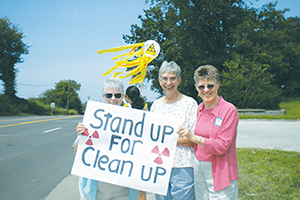
From left, Sr. Rose Dowling, FSM; Sr. Joyce Engle, SSND; and Sr. Mary Jordan, FMSA, demonstrate near the West Lake Landfill in Bridgeton, Mo., to build awareness of the nuclear waste threat at the site. The Franciscan Sisters of Mary held the public prayer and advocacy vigils every other week for several years.
As members of the Bridgeton community, congregation members have attended numerous public forums and meetings of neighborhood coalitions involved in the struggle over environmental remediation. They write letters to public officials about what is at stake in Bridgeton and related nuclear waste sites in the St. Louis area.
Up until last fall, when, at long last, the Environmental Protection Agency unveiled the specifics of its evolving plan to clean up the Superfund site, members of the congregation could be found every other week praying and demonstrating on a parking lot not far from St. Louis Lambert International Airport and across the street from the Superfund site, the West Lake Landfill. The site has been on the EPA's list of priorities since 1990.
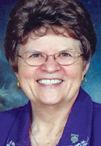
Sr. Derer
Sr. Jeanne Derer, FSM, leads the congregation's work seeking a resolution to what they and many Bridgeton residents see as a public health threat posed by the nuclear contamination at the West Lake Landfill and the foul-smelling fumes emanating from an adjacent dump, the Bridgeton Landfill. "We're grateful to speak on the people's behalf and to seek healing for them," she says.
Fire in the hole
The urgency around the Superfund site has dialed up considerably since about 2010, when a smoldering underground fire was discovered at the Bridgeton Landfill.
The Bridgeton and West Lake landfills are in former rock quarries connected by a geographic formation called a neck. If the slow-moving fire in the Bridgeton Landfill crosses the neck, it could reach the nuclear contaminants in the West Lake Landfill, potentially posing a significant public health threat. School districts and a fire department near the landfills have created disaster preparedness and evacuation plans in response to the potential hazard.
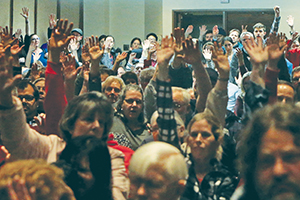
During a March 2018 meeting to solicit public comment on the Environmental Protection Agency's Superfund cleanup plan for the West Lake Landfill, locals raise their hands in support of full excavation and off-site removal of radioactive waste contamination. The EPA's final plan released in September calls for the removal of about 70 percent of the nuclear waste.
Robert Cohen/St Louis Post-Dispatch
In a 2009 Hazardous Waste Management Commission report, The Missouri Department of Natural Resources says the contamination of the West Lake Landfill site traces in large part to 1973 when a corporation mixed radioactive residues with about 47,000 tons of fill soil used to cover garbage and construction materials disposed of at the landfill.
In Atomic Homefront, a 2017 documentary film on the Superfund site, Bridgeton-area residents describe premature deaths of loved ones from rare cancers that they link to exposure to radiation emanating from the dump. The documentarians followed a woman and boy as they underwent treatment for cancers they believed to be associated with radiation exposure; both have since died. Activist groups featured in the documentary have created maps pinpointing the residences of local people diagnosed with various types of cancer.
Menace in the air
Sr. Derer says the congregation became aware of the threat posed at the landfills and other sites in St. Louis County tainted by radioactive waste after relocating its headquarters to Bridgeton from another St. Louis suburb in 2010 and 2011. Staff complained of ghastly smells indoors and outside the offices. The sisters learned that the odor was coming from the underground fire at the Bridgeton Landfill less than 2 miles from their office. Thirty-two of the congregation's elderly sisters live in a continuum of care facility near the congregation's office.
Troubling fallout
The nuclear waste buried in the West Lake Landfill is a by-product of the World War II nuclear arms race. St. Louis' Mallinckrodt Chemical Works, now called Mallinckrodt, processed the uranium used in the Manhattan Project — the effort yielded materials for the nation's first atomic bombs.
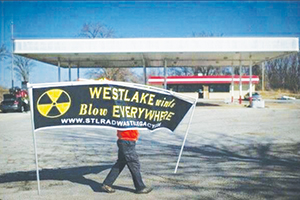
For several years the Franciscan Sisters of Mary held an every other week vigil at an abandoned gas station near the West Lake Landfill Superfund site in Bridgeton, Mo. Gayle Thackrey
After studying the issues created by the haphazard disposal of remnants of the uranium processing in north St. Louis County, touring the perimeters of the landfills and meeting with concerned citizens and activists, the Franciscan Sisters of Mary decided as a congregation in 2016 to make the West Lake Landfill issue a top Franciscan Sisters of Mary focus.
Sr. Derer says the sisters felt compelled to act because the congregation's charism calls its members to be a presence to suffering people and to serve them compassionately, as Jesus served others.
She says she "could sense at West Lake the potential of a huge, huge danger. And, not just to the people living around the landfills, but also for many generations to come, from that radioactive waste."
Slow walk
Bridgeton residents and other activists, as well as community leaders, have been frustrated by what they say is the lack of action on the part of the government and the private companies tied to the contamination and responsible for helping pay for the cleanup.
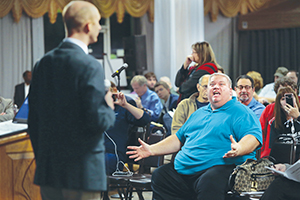
During a public meeting last month, Mike Mason, at right, calls for a buyout of community members living in proximity to the Bridgeton Landfill, part of the West Lake Landfill Superfund site. He addresses Jonathan Garoutte, a Missouri Department of Health and Senior Services section administrator. Garoutte was discussing the state's findings on the health effects of gases and fumes from the Bridgeton Landfill. Laurie Skrivan/ St Louis Post-Dispatch
Sr. Derer says the sisters have used their influence to recruit SSM Health and its SSM Health DePaul Hospital in Bridgeton to advocate with local, state and federal legislators to spur those responsible for the cleanup to action and to push for legislation assisting local residents, through a buyout or other means. The congregation and health system have run letter-writing, email and phone campaigns, to keep public officials' attention on the West Lake Landfill.
In September, the EPA issued a plan to remove about 70 percent of the tainted soil and debris from West Lake Landfill and transport it out of state to an approved nuclear waste facility. The plan calls for the remaining waste to be capped with a nonporous protective barrier. While some activists are encouraged by the progress, others say it falls short.
In addition, the St. Louis Post-Dispatch reported that Bridgeton residents expressed their ire at the Missouri Department of Health and Senior Services during a public forum last month. The state was following up on its findings that the sulfurous fumes coming from the Bridgeton Landfill did not cause an increased risk of cancer, but had triggered asthma and other breathing problems, especially in children and elderly adults.
Sr. Derer says there are still countless, and hugely complex unresolved issues with the EPA Superfund site cleanup plan too. She says it will be enormously difficult to address all of the concerns the site poses.
Sr. Derer says she and other sisters are in it for the long haul. They have become part of the lives of people affected by contamination.
The sisters have prayed with and for residents who have been impacted by cancer, offering consolation and support as they process grief and loss. Sr. Derer says, "It's a privilege to be able to interact with all the people who have been involved with this, and to take this stand on protecting life."
View the site map
Franciscan Sisters of Mary focus on their legacy in congregation's 'journey toward completion' The Franciscan Sisters of Mary — the founders of St. Louis' SSM Health — made a prayerful decision in 2001 to "journey toward completion." The congregation, which reached a peak membership of 500 in the 1960s, had not admitted a new member since 1979. It would focus its energy and financial resources going forward on making sure the sisters' work lives on after them. 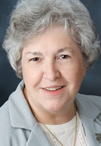 Sr. Bell Today there are 58 Franciscan Sisters of Mary, all but 27 of them retired from active ministry. The youngest is turning 62 this month. Despite their small numbers, the Franciscan Sisters of Mary have an outsized influence in the communities where the congregation has established ministries, says congregation President Sr. Judy Bell. This is in part because of how intentionally and methodically they have ingrained their charisms into SSM Health and in part because they have devoted their lives to living the Gospel call to love one another, to being the compassionate, healing presence of Jesus and to valuing and protecting human life. The sisters have no intention of retiring from the pursuit of those ideals.  Sr. Ryan Care of creation
Sr. Mary Jean Ryan, FSM, was the first president and chief executive of SSM Health, a system the Franciscan Sisters of Mary formed in 1986 to centralize its hospitals and health facilities. She says that heading the system for 25 years, she was able to mesh the congregation's priorities for advancing the greater good into executive decision making at SSM Health. Guiding the sisters' work and influencing the health system's priorities, she says, is a Declaration of Nonviolence the congregation issued in 1994, in which it committed to value and protect human life, heal the wounded, help the vulnerable, preserve the earth, work for peace and oppose violence. As head of SSM Health, Sr. Ryan initiated the system's bans on Styrofoam containing chlorofluorocarbons in the 1990s and bottled water in 2008. She directed staff not to use words that gratuitously connote violence. To this day, PowerPoint presentations at SSM Health have "dot points," not "bullet points." From the outset, the system employed women in executive leadership and it sought out and groomed female and minority talent. SSM Health implemented a socially just minimum wage systemwide in 2017, and its benefits structure provides special consideration for those who are most vulnerable, says Brian Westrich, SSM Health spokesperson. Sr. Ryan says the congregation and system "were very deliberate" in creating a health system culture that embodies the sisters' values. Today, Laura Kaiser, president and chief executive of SSM Health, says, "It is impossible to separate the ministry of the sisters from the whole ministry here at SSM Health."  Kaiser Financial philosophy
As the Franciscan Sisters of Mary focus on their legacy, they carry the good faith intentions of the 800-plus sisters who have preceded them. The congregation traces its origins to 1872 when Mother Mary Odilia Berger and five other sisters arrived with few resources in St. Louis from Germany to care for the poor and sick. As the congregation grew, the sisters established health care facilities in Missouri and in several other Midwestern states. Its members worked in clinical, administrative and other roles. "Many of us worked side by side with the sisters, and it was wonderful," says Paula Friedman, SSM Health's chief strategy officer. As the size of the congregation continued to wane in recent decades, the Franciscan Sisters of Mary could no longer maintain the same presence at SSM Health facilities. As part of its legacy planning, the congregation in 2013 transferred sponsorship of SSM Health to SSM Health Ministries, a ministerial public juridic person. The structure allows for laity to serve as sponsors, though Franciscan Sisters of Mary are still on the sponsor board.  Sr. Dowling All of the Franciscan Sisters of Mary have taken vows of poverty, and any compensation they earn goes directly to the congregation. Sisters who inherited wealth over the years willingly signed over the money to the congregation, according to information from the congregation. Additionally, the congregation is supported by some proceeds from the health system. Sr. Rose Dowling, FSM, former president of the congregation, says the congregation's financial and philanthropic decisions are backed by a moral and financial imperative for stewardship that traces back through the generations of women religious. "Much of what we've been able to do has been so dependent on the sisters that have gone before us," says Sr. Bell. "They were very wise women who were very dedicated and worked long hours because they believed in bringing the ministry of Jesus to the people." Investing to change the world
The Franciscan Sisters of Mary and SSM Health follow socially responsible investing principles, ensuring their investment dollars do not go to companies that violate the sisters' values. Both congregation and system also have used shareholder resolutions, dialogue with companies and other investor leverage to encourage companies to act in socially and environmentally responsible ways. 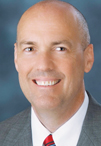 O'Shaughnessy In 2012, the congregation began mission-related investing, also known as impact investing, says John O'Shaughnessy, the Franciscan Sisters of Mary's chief executive and chief financial officer. The congregation has committed $10 million to such investments, which generate a positive social or environmental impact in line with Franciscan values and priorities. This includes investments to address climate change, to promote sustainable use of natural resources, to clean up the environment and to promote community development. "Most of our mission-related/impact investments are private investments; i.e., private equity, private credit and private real assets. This (mission-based investing) represents 15 percent of our overall investment program," he explains. "We are now allocating another 5 percent to a climate-focused investment fund that is made up of publicly traded securities, including stocks and bonds." Giving it away
O'Shaughnessy notes that a few years ago the congregation decided it did not want its financial assets to outlive the congregation's membership. The congregation would spend down surplus assets, and decide for itself how best to do that, rather than have that money placed in a perpetual endowment, he explains. "The next step was to plan and develop a philanthropy program for granting funds to further FSM's mission and focus in a way that would gradually spend down surplus assets." O'Shaughnessy says the sisters apply similar priorities to their philanthropic work. Their grant making is devoted to mitigating the effects of climate change, encouraging sustainable farming, expanding access to clean water, and promoting access to healthy food for low-income people and other vulnerable populations. He said the congregation just completed its fourth year of grant making and expects the program to continue for 12 to 15 years. SSM Health has mirrored the congregation's approach to investing and philanthropy, applying a similar set of guidelines and following a mission-related investment strategy, O'Shaughnessy says. In the past five years, SSM Health expanded with the addition of facilities of the Felician Franciscan Sisters of Chicago and the Congregation of Sisters of St. Agnes of Fond du Lac, Wis. Today SSM includes 24 hospitals and 300-plus other health care sites in Illinois, Missouri, Oklahoma and Wisconsin. SSM has more than 40,000 employees. — JULIE MINDA |